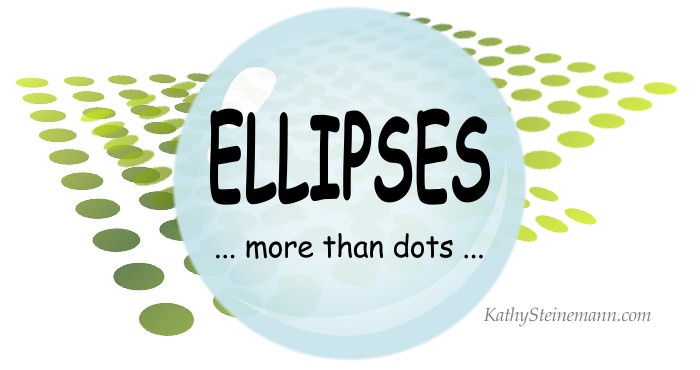
Before We Begin, Let’s Consider the Definition of Ellipsis
ellipsis: a sign (such as …) used in printed text to show that words have been left out; can also indicate a pause, or an unfinished thought or sentence.
Scattered judiciously, ellipses add clarity and character to a piece.
Creative writers most commonly lean on ellipses to show pauses in speech or action. Depending on the style guide, you’ll see either of two approaches:
She stopped at the door … and waited.
She stopped at the door . . . and waited.
Both are complete sentences that could also be expressed as:
She stopped at the door and waited.
Consider the differences between the preceding examples and these.
She stopped at the door. … It was locked.
She stopped at the door. . . . It was locked.
A pause in action separates two complete sentences. Each sentence ends with a period, which is followed by a space, an ellipsis, and another complete sentence.
Note: There is no such thing as a four-dot ellipsis. I repeat, and the style guides agree: There is no such thing as a four-dot ellipsis.
Consider the Following Examples
The teacher spoke so rapidly that the student was unable to record everything she said. “The world is dying. … floods, earthquakes. We must act now.”
The teacher spoke so rapidly that the student was unable to record everything she said. “The world is dying. . . . floods, earthquakes. We must act now.”
The second example, similar to the second example in the locked-door sentences, seems to contain a four-dot ellipsis. However, the four dots represent the closing period of a complete sentence, a space, and a three-dot ellipsis to indicate a missing word or words, plus the rest of the quoted speech.
The Writer’s Lexicon series
and additional resources on my Facebook page.
Spaces … Spaces … Don’t Omit the Spaces
The Chicago Manual of Style, The Associated Press Stylebook, Painless Grammar, and The Copyeditor’s Handbook all agree on one point:
Ellipses should be set off by spaces.
Correct:
She stopped at the door … and waited.
She stopped at the door . . . and waited.
Incorrect:
She stopped at the door…and waited.
She stopped at the door. . .and waited.
If you omit the surrounding spaces, this is how your words could split at the end of a sentence:
Julie heard something in the hall. She stopped at the
door…and waited.
Julie heard something in the hall. She stopped at the
door. . .and waited.
Software treats the combination of door…and as a single word, moving the phrase onto the next line. When you use spaces as the style guides recommend, sentence splits appear more logical. You might see something like:
Julie heard something in the hall. She stopped at the door …
and waited.
Because ellipses are sticky punctuation, they remain attached to the words they adjoin.
The only time you break the rule about surrounding ellipses with spaces is in this type of situation:
She yelled, “Get out or …”
She yelled, “Get out or . . .”
If you precede the closing quotation mark with a space, you could end up with the following scenario, isolating the quotation mark at the beginning of an empty line:
She yelled, “Get out or …
”
She yelled, “Get out or . . .
”
Two More Sources That Recommend Surrounding Ellipses With Spaces
University of Bristol: “It should be noted that the ellipsis consists of a space, three dots and a further space. There should be a space between the dots and the text.”
Oxford University Press. “You should use three full points, spaced from each other and from the words either side.”
Why I Don’t Like . . . Ellipses
If you use the . . . approach, Microsoft Word and many other text editors will count each period as a separate word. When you’re writing flash fiction or short stories where economy of words is important, that can create a huge problem.
This sentence counts as five words in MS-Word: He whirled … and fell.
This one as seven: He whirled . . . and fell.
Another difficulty with . . . ellipses is the way they often divide at the end of a line. You could wind up with confusing splits like:
She stopped at the door . .
. and waited.
That’s unattractive and confusing.
Non-breaking spaces between the dots solve the problem, but not all software makes it easy to insert them. The key sequence in MS Word for a non-breaking space is CTRL-SHIFT-SPACE.
To convert the ellipsis in He whirled . . . and fell, the MS-Word sequence would be:
He whirled [SPACE] . [CTRL-SHIFT-SPACE] . [CTRL-SHIFT-SPACE] . [SPACE] and fell.
Why … Why … Why?
We live in the twenty-first century. Why do some style guides, publishers, and copyeditors still cling to the old-fashioned dot-space-dot-space-dot ellipsis?
It’s ugly. It’s word-bloating.
Let’s kick it to the curb.
The Writer’s Lexicon series
and additional resources on my Facebook page.
Discover more from KathySteinemann.com: Free Resources for Writers
Subscribe to get the latest posts sent to your email.

Now I’m confused, but I’ll look it up in my copy of The Chicago Style Handbook now. I recall being advised, after leaving no space between fore aft after, that I should only leave one space… before the trailing word, which certainly seems neat and logical. Later, was advised to eliminate all spaces
A couple of quotes from CMOS 16:
Does that help?
Thanks for stopping by, Jerold.
Good luck with your writing!
I already knew about the conventions governing when to use ellipses and when to use a dash/hyphen, but your explanation about how many and where to put the spaces was very thorough and enlightening. Thanks for sharing.
Glad I could help, Tom. I wish all the style guides would get together and standardize.
Speak the plain truth, O guru of ellipses! 🙂
Thanks, Lee. 😉